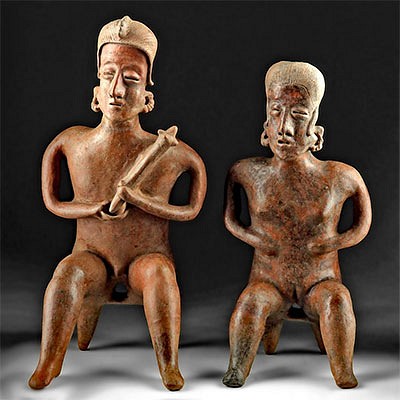Fine Early Byzantine Glass Juglet w/ Molded Patterns
Lot 53
About Seller
Artemis Fine Arts
686 S Taylor Ave, Ste 106
Louisville, CO 80027
United States
Selling antiquities, ancient and ethnographic art online since 1993, Artemis Gallery specializes in Classical Antiquities (Egyptian, Greek, Roman, Near Eastern), Asian, Pre-Columbian, African / Tribal / Oceanographic art. Our extensive inventory includes pottery, stone, metal, wood, glass and textil...Read more
Categories
Estimate:
$2,500 - $3,000
Absentee vs Live bid
Two ways to bid:
- Leave a max absentee bid and the platform will bid on your behalf up to your maximum bid during the live auction.
- Bid live during the auction and your bids will be submitted real-time to the auctioneer.
Bid Increments
| Price | Bid Increment |
|---|---|
| $0 | $25 |
| $300 | $50 |
| $1,000 | $100 |
| $2,000 | $250 |
| $5,000 | $500 |
| $10,000 | $1,000 |
| $20,000 | $2,500 |
| $50,000 | $5,000 |
| $100,000 | $10,000 |
| $200,000 | $20,000 |
About Auction
By Artemis Fine Arts
Mar 25, 2021
Set Reminder
2021-03-25 10:00:00
2021-03-25 10:00:00
America/New_York
Bidsquare
Bidsquare : CLEARANCE Antiquities | Ethnographic Art
https://www.bidsquare.com/auctions/artemis-gallery/clearance-antiquities-ethnographic-art-6663
Featuring discounted pricing on Asian art, Classical antiquities from Egypt, Greece, Italy, and the Near East...plus Pre-Columbian, Tribal, Russian Icons, Spanish Colonial, Fine Art, more! Artemis Fine Arts info@artemisgallery.com
Featuring discounted pricing on Asian art, Classical antiquities from Egypt, Greece, Italy, and the Near East...plus Pre-Columbian, Tribal, Russian Icons, Spanish Colonial, Fine Art, more! Artemis Fine Arts info@artemisgallery.com
- Lot Description
**Originally Listed At $2000**
Ancient Near East, Holy Land, early Byzantine Empire, ca. 6th to 7th century CE. A superb example of a tall Byzantine juglet, mold-blown from translucent glass of an attractive blue-green hue. The delicate vessel features a concave base with a rough pontil scar, a rectangular body with smooth upper corners and a tapered shoulder, a cylindrical neck, a funnel-form rim with an in-folded lip, and a trail handle that arches between the rim and shoulder. All four sides of the body are decorated with intricate mold-formed patterns. Beginning the with panel beneath the handle and moving to the right, the patterns include a vertical tabula ansata with a net pattern; a shrine with a triangular gable and a hanging lamp; a broad netted pattern; and another shrine with a triangular gable and a hanging lamp. Fine layers of silvery and rainbow-hued iridescence have formed across the entire juglet and complements the vessel's soft turquoise color. Size: 2.2" W x 5.625" H (5.6 cm x 14.3 cm)
For a stylistically similar example with a hexagonal body, please see "Glasses of Antiquity." Fortuna Fine Arts, Ltd., New York, 2002, fig. 115.
For other examples, please see: Moussaieff collection, p.44; Israel Museum collection, (H) no. 452; Oppenlander collection, no. 500.
Provenance: private Florida, USA collection, purchased at the Archaeological Center auction, Tel Aviv, Israel (January 20, 2010, lot 158); ex-Bineth Gallery of Fine Art, Gershon Bineth collection, Jerusalem, Israel
All items legal to buy/sell under U.S. Statute covering cultural patrimony Code 2600, CHAPTER 14, and are guaranteed to be as described or your money back.
A Certificate of Authenticity will accompany all winning bids.
We ship worldwide and handle all shipping in-house for your convenience.
#151608Professional restoration to handle but it is unobtrusive to the overall presentation. One stable fissure stemming from rim to middle of neck. Minor abrasions to base, body, rim, and handle, with micro-bubbling within glass matrix, light weathering film and encrustations, and minor softening to some pattern-molded details. Pontil mark on underside of base. A pontil scar or mark indicates that a vessel was free-blown, while the absence of such a mark suggests that the work was either mold-blown or that the mark was intentionally smoothed away or wore away over time. Nice earthen deposits as well as fine silver and rainbow iridescence throughout.Condition
- Shipping Info
-
All shipping is handled in-house for your convenience. Your invoice from Artemis Gallery will include shipping calculation instructions. If in doubt, please inquire BEFORE bidding for estimated shipping costs for individual items.
-
- Buyer's Premium



 EUR
EUR CAD
CAD AUD
AUD GBP
GBP MXN
MXN HKD
HKD CNY
CNY MYR
MYR SEK
SEK SGD
SGD CHF
CHF THB
THB
















